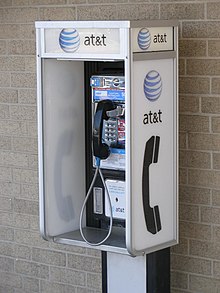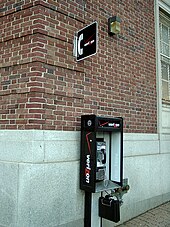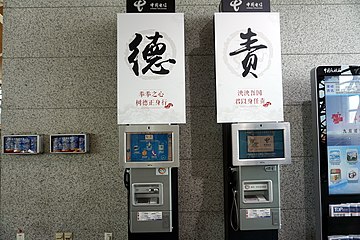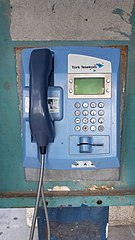| This article needs additional citations for verification. Please help improve this article by adding citations to reliable sources. Unsourced material may be challenged and removed. Find sources: "Payphone" – news · newspapers · books · scholar · JSTOR (February 2012) (Learn how and when to remove this message) |

A payphone (alternative spelling: pay phone or pay telephone or public phone) is typically a coin-operated public telephone, often located in a telephone booth or in high-traffic public areas. Prepayment is required by inserting coins or telephone tokens, swiping a credit or debit card, or using a telephone card.
The company that operates the payphone generally pays either rent or a revenue share to the owner of the property where the phone is installed.
Invented in the late 19th century, payphones became ubiquitous worldwide in the 20th, enough to contribute to the notion of universal access to basic communication services. The charge for a call may be a flat rate, or dependent on call duration. Following the explosive growth of mobile telephony, the use of payphones, and the number installed, has decreased greatly.
Countries
Canada

Most payphones in Canada are owned and operated by large telecom providers such as Bell, Telus, and SaskTel. In the last 20 years, customer-owned coin-operated telephones (COCOT) have also appeared in the market, but their numbers are smaller due to the emergence of mobile phones.
The cost of most local payphone calls is 50 cents CAD, having increased from 25 cents since 2007. Payphones in Alberta were 35 cents for a time, but in most jurisdictions the price simply doubled. Newer phones allow users to use calling cards and credit cards. For coin-paid long distance, COCOTs are less expensive for short calls (typically $1 for three minutes) than incumbent providers (whose rates start near $5 for the first minute).
Dialing 0 for the operator and 911 calls are still free.
The Toronto Transit Commission deploys payphones on all subway platforms as a safety precaution; a blue "Crisis Link" button on 141 payphones connects directly with Distress Centres of Canada as a free suicide prevention measure.
As of 2013, there were about 70,000 payphones across the country.
In 2013, the CRTC issued a temporary moratorium on the removal of payphones in small communities.
In September 2015, the CRTC remarked that "32 percent of Canadians used a payphone at least once in the past year," and that they are used "as a last resort in times of inconvenience and emergency."
Germany
The payphone model 23, introduced at Deutsche Bundespost Telekom in 1992, is an electronic software-controlled payphone for analog connections. It is equipped with coin, (German: Münzspeicherwagen), and integrated test program setting. It has a remote maintenance – the independent reports of a background system by means of an integrated modem error (for example, defects in components, lack of listeners), operating states (for example, full coin box), or departures (for example standing open the cartridge mounting door, missing coin).
The Payphone 23 consists of two basic units, the equipment part including all the necessary for the operation modules (BG) and the secured below the growing payphone cassettes with the coin box.
-
 Payphone in Munich, 2022
Payphone in Munich, 2022
Italy
In Italy, public payphones have been installed and maintained over the years by Telecom Italia (formerly SIP).
Many public telephones were removed in the early 2010s, but there are still several thousand in operation throughout Italy.
From 26 May 2023, following an AGCOM decision, TIM-Telecom Italia is no longer obliged to keep public telephones in service (but still has the option to do so). In hospitals, prisons, barracks and mountain refuges, the provision of public telephone services is in any case mandatory.
-
 Payphone model U+I from 1964 to 1982
Payphone model U+I from 1964 to 1982
-
 Payphone model G+M from 1982 to 1987
Payphone model G+M from 1982 to 1987
-
 Payphone model Rotor from 1987 to 2002
Payphone model Rotor from 1987 to 2002
-
Payphone model Digito since 2002
Japan

The majority of payphones on the street and in buildings in Japan are installed and maintained by Nippon Telegraph and Telephone (NTT).
Russia
In the Soviet period, different types of payphones were produced. There were also long-distance call payphones costing 15 kopeks, and also provided services of paid media such as listening to an anecdote, obtaining legal advice, or finding the address of the subscriber by phone number. After the collapse of the Soviet Union and the monetary reform of 1991, this form of payment became irrelevant. Some payphones were altered to accept tokens, while others have been designed to use telephone cards. For example, in St Petersburg, payment for payphones can be made with metro tokens. In some regions, calls from public phones are free of charge.
Spain
Telephones were a monopoly of the national government in Spain. Payphones took a slug or ficha, a piece of metal with two troughs in it, making it hard to counterfeit. Payphones were typically found in bars, restaurants, and stores, never freestanding. Phones would accept some five fichas at a time (the exact number varied depending on phone model), showing through a plastic window the number remaining, and return unused ones to the customer.
An older and simpler system was to use a mechanical counter, the marcador de pasos, which automatically counted units of time called pasos. The duration of each paso depended on the distance of the call, and its cost could vary by time of day. At the conclusion of a call a human attendant would collect the appropriate payment. This system survived in small hotels at least until the 1970s. Spain also had locutorios ("speaking places"), where a person could make and pay an attendant for phone calls. Locutorios diminished in the 21st century, as the country moved to direct distance dialing and mobile phones.
United Kingdom
Main article: Red telephone boxThe telephone service in Britain was run by the General Post Office (GPO), a state monopoly, which had taken over the National Telephone Company in 1912. Coin-operated payphones in Britain in about 1950 cost 2d (2 old pence) for a local call of unlimited duration. This eventually increased, and by about 1960 calls were timed, costing 3d for 3 minutes. Long-distance calls, connected by an operator, cost more. Telephones had a coin slot and two buttons, marked A and B. One or more coins had to be inserted and the number dialled. If answered, the call was enabled by pressing button A; if not answered, button B returned the coins. Payphones later changed and the old A/B button design was dropped; prices changed over time.
The telephone system was privatised in 1984, operated by British Telecom, still a monopoly. Phone cards were introduced for paying for calls. Payphones were later deregulated, no longer a BT monopoly. The great majority of them are still operated by British Telecom (BT) but other companies provide services, mostly in urban areas. Hull, Manchester, London, Cardiff and Glasgow, at the turn of the 21st century, have a greater concentration of non-BT payphones, since BT has been removing many payphones which are unprofitable. The use of payphones declined greatly in Britain, as everywhere, with the explosive growth of mobile telephones.
- Kiosk adoption
BT allows local communities to adopt the iconic Red K6 Kiosks due to strong opposition to their removal from the communities that the kiosks reside in. This will mean the removal of the phone, leaving the empty kiosk in-situ.
- Sponsored kiosk
Another option BT has provided is the sponsored kiosk, that will retain the phone service, and retain the kiosk for an annual fee of around £300 excluding VAT, whether it is the Red K6 or the newer aluminium and glass kiosks that cannot be adopted.

Payphone types
Due to disability discrimination law, specifically the Disability Discrimination Act 1995, in the past payphone providers were required to provide a certain number of textphone payphones as part of their network, as this was deemed a "reasonable adjustment" for deaf customers. These phones can also make voice calls, as well as send SMS and e-mail messages, and although this requirement is no longer in force due to minimal use of the textphone feature in these phones, many of these devices remain in service, generally in populated areas.
In addition, in the early 2000s BT installed a large number of 'Multiphones' that provided internet access, on top of voice, SMS, and e-mail functionality. These payphones provided these services through the use of a 2-channel ISDN2 connection, a QNX-based operating system, and a touchscreen interface to allow the user to browse websites and receive e-mail messages on a pay-per-minute basis. However, these devices have since been removed due to quickly becoming obsolete, often with the ordinary payphone previously installed in that location taking its place once again.
- Cost
From 1 June 2010, BT payphones have a £0.60 minimum charge which is for the first 30 minutes of any direct-dialled national geographic call. Previously the minimum charge was £0.40 for the first 20 minutes of any direct-dialled national geographic call. Then before November 2006 the minimum charge was £0.30, before 2004 it was £0.20 and before 2000 it was £0.10. Credit/debit cards can also be used, and many BT payphones have card readers for this service; however, calls made using a card are charged at a significantly higher rate than calls made using cash.
BT Phonecards purchased from participating retailers were introduced in 1981, and could be used in most BT payphones to pay for calls. Cards originally used an optical system to register credit, changed to a chip-based system in the 1990s, and were withdrawn in 2003.
In the past, a BT Chargecard could be used from any UK landline to charge any telephone calls made to the cardholder's BT home telephone account, with no charge to the landline the card was being used from. These were most commonly used in payphones, and some BT payphones had dedicated readers for these cards. This service was discontinued in 2018. Other cards which are often used instead include supermarket international calling cards and many other telephone cards which can be bought from newsagents.
Although 0800 and 0808 numbers are free to the caller when dialled from most payphones, the owner of the number called must pay a 'Payphone Access Charge' (PAC) which has increased significantly in recent years, and is currently £0.79 per minute if their number is called from a payphone. This has led to many businesses, and even calling card providers, barring calls to their freephone numbers originating from payphones. Charity helplines are exempt from this charge if called from a BT payphone, however this exemption does not apply to calls made from payphones owned by other providers, and in these cases the charity must pay the PAC.
- Cost examples (from BT coin-operated payphones)
There is a £0.40 connection charge, in addition to the "per minute" charges shown below, and a minimum charge of £0.60. Some payphones also offer SMS and e-mail service, both charged at £0.20 per message.
| Call prefix | Type of call | Seconds per £0.10 block | Cost per minute |
|---|---|---|---|
| 0800/0808/116 | Freephone | Free to caller | Free to caller |
| 01/02/03 | Landline (local/national) | 900 | £0.0067 |
| 07 (most) | Mobile | 9.5 | £0.63 |
| 070/076 | PNS/Pagers | 3 | £2.00 |
| 0845 | Non-geographic ('Special Services') – 'Lo-Call' | 30 | £0.20 |
| 0870 | Non-geographic ('Special Services') – 'National' | 12 | £0.50 |
| 09 | Premium-rate services ('PRS') | 1.5 | £4.00 |
| 123 | Speaking clock ('Timeline') | 5 | £1.20 |
United States

"Dead-heads" may have influenced the development of the payphone, non-subscriber users who made a call at a place of business and did not pay for it. The Wisconsin Telephone Company in 1893, for example, attempted to put an end to this practice by implementing ten-cent coin slots so that users had to pay for the call. The idea behind this was to reduce the financial stress a smaller business may face from having dead-heads.
Payphones were preceded by pay stations, staffed by telephone company attendants who would collect rapid payment for calls placed. The Connecticut Telephone Co. reportedly had a payphone in their New Haven office beginning 1 June 1880; the fee was handed to an attendant. In 1889, a public telephone with a coin-pay mechanism was installed at the Hartford Bank in Hartford, Connecticut, by the Southern New England Telephone Co. It was a "post-pay" machine; coins were inserted at the end of a conversation. The coin mechanism was invented by William Gray; he was issued a series of patents for his devices, beginning with U.S. patent 454,470 issued 23 June 1891 for a "Signal Device for Telephone Pay-Stations" which rang a bell for each coin inserted. He subsequently founded the Telephone Pay Station Co. in 1891. The "pre-pay" phone debuted in Chicago in 1898.
In the late 1920s, the cost of a payphone call in the United States was two cents. In the 1930s, calls were five cents; the cost of a typical local call had risen to 10 cents by the 1960s, 15 cents during the 1970s, then 25 cents in the 1980s. By the early 21st century, the price of a local call was usually fifty cents. The rise of mobile phones led to the near extinction of payphones by the early 21st century. New York City, which once had 30,000, removed its last public payphone in 2022.
The Bell System payphone took nickels (5¢), dimes (10¢), and quarters (25¢); a strip of metal along the top had holes the size of each coin. The US slang term "drop a dime" means to inform the authorities about another person, originally by placing a toll call from a pay phone. It can also refer to the placing of a phone call for social purposes. The term has risen in popularity in the US since the 1980s, and is still in use since 2000, despite the price increase of pay phones and the rise of mobile phones.

Payphone calls generally cost 5¢ into the 1950s and 10¢ until the mid-1980s. Rates standardized at 25¢ during the mid-1980s to early 1990s. The Bell System was required to apply for increases through state public service commissions. Therefore, the actual increases took effect at different times in different locations. The small town of Beggs, Oklahoma attracted national attention in the late 1970s when public payphones offering calls for only five cents had been essentially phased out across the country, but Beggs still had one. As of 2020, Beggs still has a nickel payphone, maintained in front of the Beggs Telephone Company office.
After the breakup of the Bell System in 1984, it was not long before independent stores selling telephones opened up. After that, privately owned payphones hit the market. Sources differ as to whether the peak number of payphones in the United States was 2.6 million in 1995 or 2.2 million in 2000. Since then the number of payphones in the United States has declined. In July 2009, AT&T officially stopped supporting the Public Payphone service. Over 139,000 locations were sold in 2009. At the end of 2012, the Federal Communications Commission (FCC) reported the number of payphones at 243,487 generating $362 million – falling to $286 million by 2015. The major carriers, AT&T and Verizon, exited the business, leaving the market to independent payphone companies. In 2018, it was estimated 100,000 payphones remained in the U.S., with roughly a fifth of them located in New York. Four years later, NYC removed its last public one, though some private pay phones remained on public property, and four full-length booths still stood in the Upper West Side in May 2022.
Gallery
-
 Payphones in China with built-in web browser
Payphones in China with built-in web browser
-
 Typical dime payphone in use in the US until the late 1960s.
Typical dime payphone in use in the US until the late 1960s.
-
 IC Payphone in Japan. This type of payphone was removed from town due to IC Card discontinued and continued to use magnetic Telephone Cards.
IC Payphone in Japan. This type of payphone was removed from town due to IC Card discontinued and continued to use magnetic Telephone Cards.
-
MC-3P Style magnetic Telephone Card accepted Payphone in Japan.
-
 Bicycle payphone in Uganda
Bicycle payphone in Uganda
-
 GTE Automatic Electric 120-type single-slot coin phone in Santa Monica, California, United States
GTE Automatic Electric 120-type single-slot coin phone in Santa Monica, California, United States
-
 Hong Kong payphone
Hong Kong payphone
-
AT&T payphone (United States)
- (video) Moving around a payphone in Japan, 2023
-
 Toronto payphones covered with graffiti and notices. Telephone books are contained in weatherproof holders hanging from the bottom of each phone.
Toronto payphones covered with graffiti and notices. Telephone books are contained in weatherproof holders hanging from the bottom of each phone.
-
 Payphone in Ashgabat
Payphone in Ashgabat
-
 A payphone in India.
A payphone in India.
-
 This Finnish payphone has a sticker saying "ei toimi" ("does not work") on it
This Finnish payphone has a sticker saying "ei toimi" ("does not work") on it
-
 Payphone in Victoria, Australia 2021
Payphone in Victoria, Australia 2021
-
 Türk Telekom payphone in Turkey.
Türk Telekom payphone in Turkey.
-
 Telus payphone in Golden, British Columbia
Telus payphone in Golden, British Columbia
-
 Indoor Verizon payphone in 2021
Indoor Verizon payphone in 2021
-
 Payphone near Richmond, Virginia, United States, 2024.
Payphone near Richmond, Virginia, United States, 2024.
See also
References
- Hopper, Tristin (3 April 2012). "What the #!%*? Bell Canada looks to raise payphone rates 100%, again". National Post. Retrieved 5 May 2015.
- Kalinowski, Tess (16 June 2011). "Woman's mental illness inspires TTC's suicide prevention program". Toronto Star. Retrieved 31 July 2016.
- "Phone booths are down in Edmonton but not completely out". Edmonton Sun. 8 March 2014. Retrieved 23 December 2014.
- ^ rob: "Canadians aren’t ready to cut cords with payphones just yet", 26 February 2015
- "La storia, in breve, della cabina telefonica" [The history – in short – of the telephone booth] (in Italian). 21 June 2018. Retrieved 1 July 2018.
- Rome, Wanted in (27 May 2023). "Italy hangs up its last public pay phones". Wanted in Rome. Retrieved 27 May 2023.
- Buck, Tobias (20 February 2014). "Migration: The drain from Spain". Financial Times. Retrieved 25 December 2023.
- "Costs of calls from British public phones, mid-20th century, section Person-to-person calls". The 1900s. Retrieved 10 March 2024.
- "Adopt a Kiosk | BT.com". Payphones.bt.com. Retrieved 31 July 2012.
- "Adopt a Kiosk | BT.com". Payphones.bt.com. 12 April 2011. Archived from the original on 20 April 2013. Retrieved 31 July 2012.
- "Adopt a Kiosk | BT.com". Payphones.bt.com. Retrieved 31 July 2012.
- "Textphones – Hansard". hansard.parliament.uk. Retrieved 20 December 2018.
- Day, Julia (25 July 2001). "BT in payphone boost". The Guardian. ISSN 0261-3077. Retrieved 20 December 2018.
- ^ "BT unveils text payphone drive". Marketing Week. 17 August 2000. Retrieved 20 December 2018.
- Nuttall, Chris (15 July 1999). "BBC News | Sci/Tech | Payphones go online". news.bbc.co.uk. Retrieved 20 December 2018.
- "BT LAUNCHES MULTIPHONE – THE PHONE BOX OF THE FUTURE". ResponseSource Press Release Wire. 15 July 1999. Retrieved 20 December 2018.
- Schofield, Jack (22 July 1999). "Dialling up the future". The Guardian. ISSN 0261-3077. Retrieved 20 December 2018.
- Banbury, Louise (17 January 2001). "BT launches free public internet access". www.campaignlive.co.uk. Retrieved 20 December 2018.
- "Payphones and Calling Cards from BT – Public payphones – payment prices". Payphones.bt.com. Retrieved 31 July 2012.
- "R.I.P. Phonecards". BBC News. 30 May 2002. Retrieved 20 December 2018.
- "payphones.bt.com". payphones.bt.com. 21 October 2011. Retrieved 25 April 2014.
- Allen, Richard (28 May 2002). "BT scraps phonecards after slump". Evening Standard. Retrieved 20 December 2018.
- "Section 2:Call Charges & Exchange Line Services Part 3:BT Postpaid (BT Chargecard, BT Odyssey, BT Adventure) – These products were withdrawn on 1st March 2018". www.bt.com. Retrieved 20 December 2018.
- "International Phonecards – Excellent Rates | Post Office". www.postoffice.co.uk. Retrieved 20 December 2018.
- Ojok, Paula (20 April 2015). "An end to Payphone Access Charges for helplines". Helplines Partnership. Retrieved 20 December 2018.
- "BT Price List". Bt.com. Retrieved 25 April 2014.
- "Payphones and Calling Cards from BT – Payphones". Archived from the original on 20 February 2014. Retrieved 21 December 2018.
- "No More Dead-Heads". Milwaukee Daily Sentinel. 17 December 1893.
- Robertson, Patrick (2011). Robertson's Book of Firsts. Bloomsbury Publishing USA. ISBN 978-1608197385.
- Newton, Harry (2006). Newton's Telecom Dictionary. Backbeat Books. p. 687. ISBN 1578203198.
- Hasbi, Maude (1 September 2014). "Universal Service Obligations and Public Payphone Use: Is Regulation Still Necessary in the Era of Mobile Telephony?". doi:10.2139/ssrn.2499391. SSRN 2499391.
{{cite web}}: Missing or empty|url=(help) - ^ Sharp, Sarah Rose (22 June 2022). "NYC's Last Public Pay Phone Is Now a Museum Artifact". Hyperallergic. Retrieved 23 July 2022.
- Osmond, Candace (25 November 2019). "Drop a Dime (or Dropping Dimes) - Origin & Meaning". Grammarist. Retrieved 25 December 2023.
- Sinclair, Molly (14 December 1981). "Bell Pushes 25 Cents As Nationwide Pay-Phone Rate". The Washington Post. ISSN 0190-8286. Retrieved 28 June 2018.
- Yarrow, Andrew L. (19 October 1992). "Goodbye, Dime Call?; 25-Cent Toll Sought in Connecticut". The New York Times. Retrieved 28 June 2018.
- "Five-Cent Phone Calls Ending in Louisiana". The New York Times. 21 December 1978. Retrieved 17 July 2020.
- "Deposit One Nickel, Please". The Argus-Press. 20 August 1977. Retrieved 17 July 2020.
- "Home Page". Beggs Telephone Company. Retrieved 17 July 2020.
- CHRISTIAN BERG (18 March 2001). "Pay phones reached their peak in "95 – Morning Call". Morning Call. Articles.mcall.com. Retrieved 10 April 2014.
- Howard Yune (1 September 2012). "Pay phones: forgotten but not gone". Napavalleyregister.com. Retrieved 10 April 2014.
- "As pay phones vanish, so does lifeline for many". USAToday. 17 December 2013.
- Universal Service Monitoring Report (PDF). Federal Communications Commission. p. 8. Retrieved 14 November 2017.
- Bensinger, Greg (12 October 2011). "Era ends as Verizon drops most of its pay phones". The Wall Street Journal Market Watch. MarketWatch, Inc. Retrieved 23 January 2013.
- "There are still more than 100,000 pay phones operating in the US". Retrieved 19 March 2018.
- "Upper West Side Is Home To NYC's Last 4 Phone Booths". Upper West Side, NY Patch. 25 October 2021. Retrieved 11 January 2023.
External links
- Pay phones: Is That Still A Thing? in the San Diego Union-Tribune.
- PayPhoneBox Index of payphone numbers and photographs of payphones in unusual or famous places around the world.
- World Payphone Images
- 2600: Payphones of the World
- Payphone tones including coin tones for the US and the UK
- For North America:
- McPayphone Directory: Project to collect America's 1.3 million payphone numbers and numbers abroad.
- Payphone Project
- Payphone Directory
- Movies and television (TV) shows that portray the use of a payphone